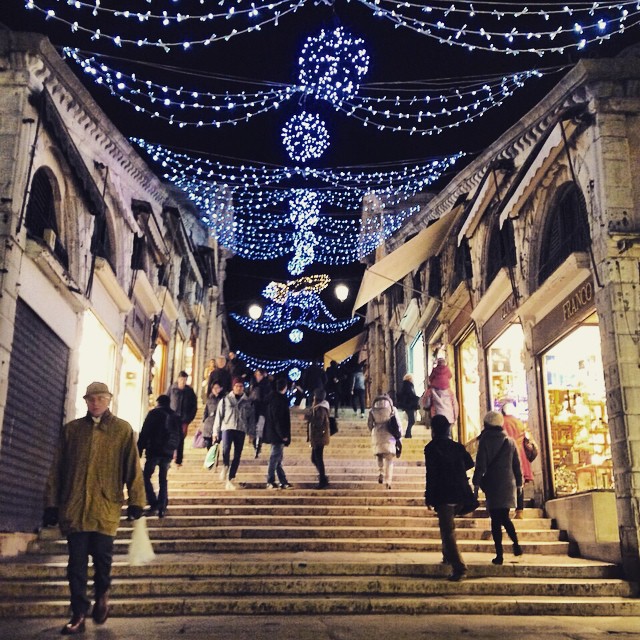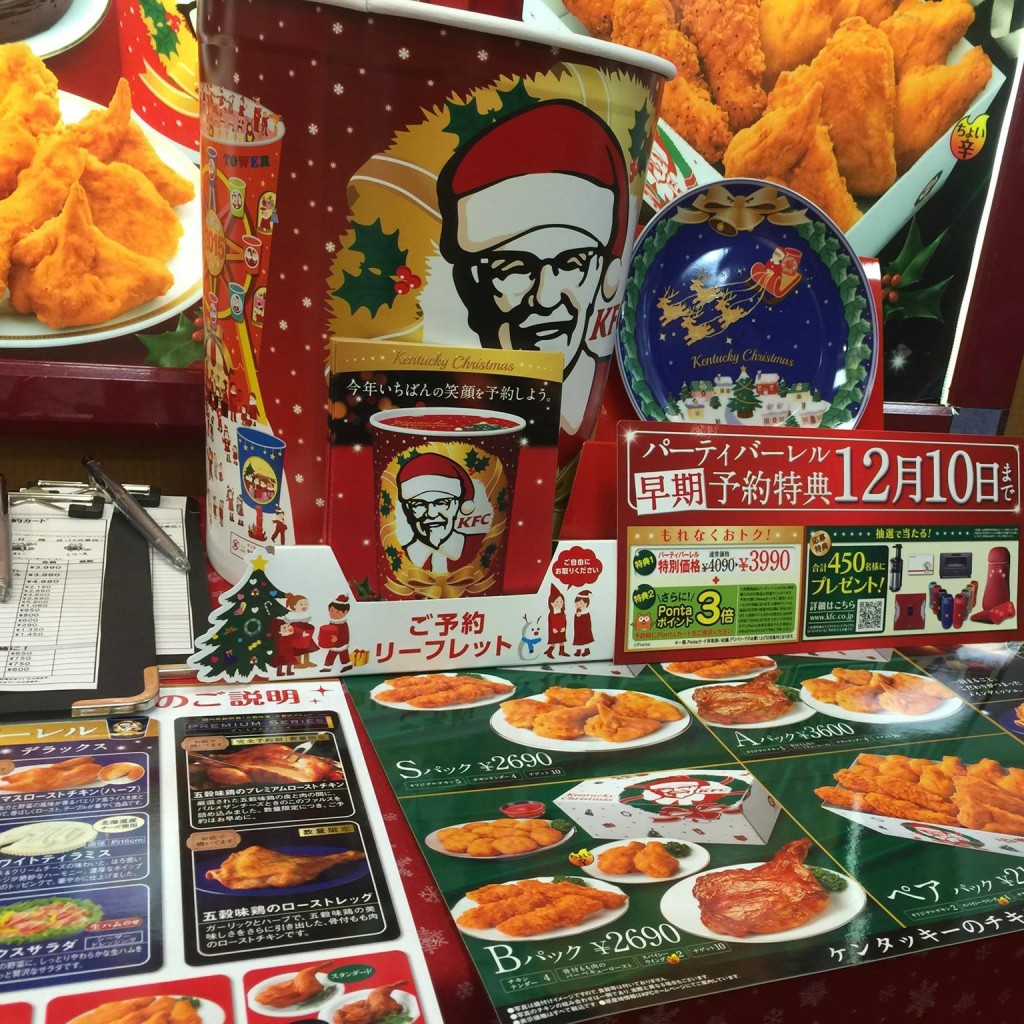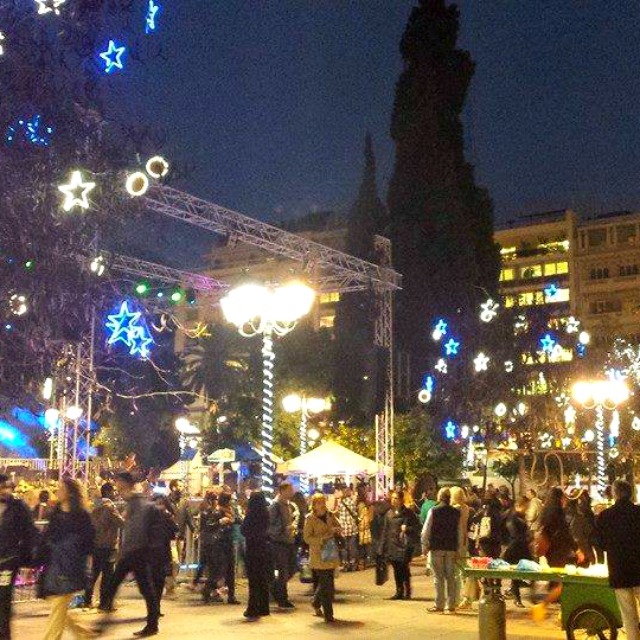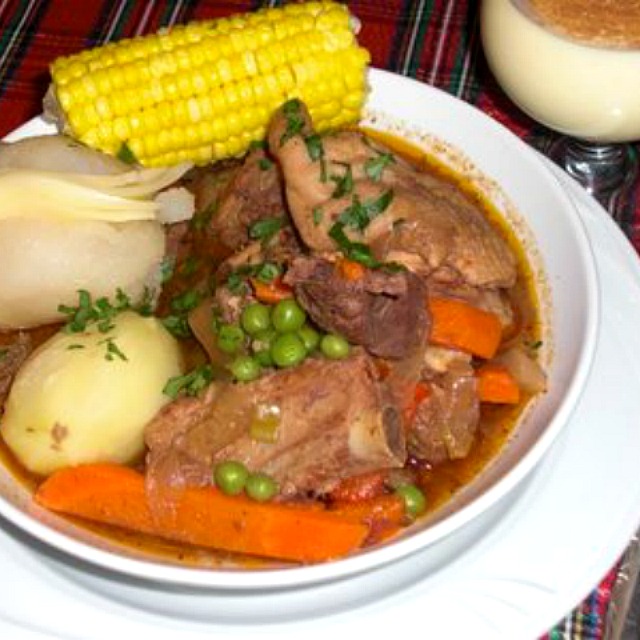
‘Tis the season to celebrate! It’s that time of year when we start thinking about Christmas, New Year’s, Hannukah, King’s Day, the solstice, and how we’re going to fit into our pants after all those holiday dinners. But because we realise that all around this great big world of ours no two celebrations are the same, we asked our global guides to tell us how they celebrate the season. From Christmas markets to giant menorahs, sticky rice balls to buckets of chicken, here are some of their favourite traditions.
New York City, USA
“Usually on the first night of Hanukkah, there’s a huge menorah put up in some public spot and lit, which is cool. The tree-lighting ceremony in Rockefeller Center has become a very big deal, where they have celebrity concerts (and huge crowds). The windows along 5th Avenue are also very traditional, and each department store dresses up their windows — starting to prep a year in advance! My family and I always avoid the area (5th Ave/Rockefeller Center and all of their insane crowds — you literally cannot walk down 5th Avenue without shuffling like cattle) until the day after Christmas. We see all of the windows and the tree the day after Christmas, with zero crowds.
“On King’s Day, I’ll sometimes go up to El Barrio (Spanish Harlem) to see the parade, and then my family will always order pasteles (similar to a tamale) through an aunt of a friend of a friend (or the sister of a friend of a hairdresser — every year it’s a scramble to find the best ‘dealer’) to eat on and around the holiday. I still put out grass and water (for the Kings and their camels) every year, and when I open the door the next morning, they’ve left a present.”
– Nikki, New York City Urban Adventures
Athens, Greece
“The singing of Christmas carols (or kalanda) is a custom preserved to this day. On Christmas and New Year’s Eve, children go from house to house in groups singing the carols, accompanied usually by the sounds of a triangle instrument, and they are given money. This year we also had a big event and concert for decorating Syntagma Square for Christmas.”
– Alexandra, Athens Urban Adventures
Krakow, Poland
“Every Krakow travel guide mentions the Christmas Market. Each year, the city centre is decorated with angels, Christmas trees, and Santa sleighs to bring in the Christmas spirit. Wooden booths are installed all over the Krakow Market Square, where you can try some of our specialties like hot wine, polish sausage, and bigos (cabbage with wild mushrooms and meat). You can also buy some typical Polish Christmas decorations and ornaments. For centuries, the first Thursday of December in Krakow has marked a competition to find the most beautiful Christmas crib in the city. Craftsmen spend months on their submissions, creating the most astonishing creations, which are regarded by many as art pieces. All renderings of this fine art can be seen first at the Krakow Christmas Market Square, and then in the Historical Museum of Krakow, Market Square 35.
“On Christmas Eve, we have the most important family dinner of the year. Traditionally we eat 12 courses, as this number is a symbol of 12 months and 12 Apostles. Before the dinner, we wish each other a Merry Christmas and share oplatek (thin wafers decorated with Nativity scenes). Later, there is a long, long dinner. There are some variations in other regions of Poland, but most of the time, we have at our tables red borsch (beetroot soup) with raviolis (uszka) or mushroom soup with pasta, fried carp with potatoes or sweet carp Jewish-style, herrings, pierogi, sauerkraut with beans, vegetable salad, and a big selection of sweets: poppy seed cake, gingerbread cake, kutia (mixture of cooked wheat grains, poppy seeds, honey, dried or candied fruits, and almonds) and dried fruit compote to drink. After a heavy meal, Santa Claus comes and gives us Christmas gifts!”
– Monika, Krakow Urban Adventures

Philadelphia, USA
“Wanamakers is THE classic Philly holiday thing. People have been going to this for some 30 years. Our downtown Macy’s is in the old Wanamaker space (Wanamaker was a department store way back in the day). It’s got this huge, seven-storey atrium, and at the top of it is the world’s largest functional musical instrument: a massive organ. They play it year round, but during the holiday season, a giant tree and old-fashioned light show are rigged up behind it. There are shows throughout the day and it’s a HUGE deal. Julie Andrews is the narrative voice and it covers all the classic holiday songs. It’s so popular that this is one of the most nuts-o points for our holiday tour because it’s always so slam-packed that all of us guides just basically give our groups a meeting point for after the show is done and then it’s every man for themselves!
“As well, the live nativity at the Old First Reformed United Church of Christ is something I love. This little bitty church is halfway between my apartment and the office, so I can pass it twice a day. They turn their mini parking lot into a live nativity with real animals that live there for the season. I think they usually have two or three sheep, a donkey, a small cow, and some goats. It’s open to everyone and you can buy feed. Plus they print up bios about the animals, so you can read how Buttons the Cow and Buttercup the Goat have grown up together (or whatever, I don’t remember the names or stories from last year, but it’s really adorable). My husband basically has to pull me away every time.”
– Kendra, Philadelphia Urban Adventures
“In Philly, it’s gotta be the Mummers Parade on New Year’s Day. Carnival meets Mardi Gras in the freezing cold!”
– Jason, Philadelphia Urban Adventures
San Sebastián, Spain
“For the Basque Country, it’s all about Olentzero, our own Santa. Spain doesn’t celebrate Santa, but rather the Three Kings — but in the Basque Country, it’s Olentzero who’s celebrated. He lives in the mountains and produces coal, and at Christmas he comes down to the valleys, with of presents for children. Also (and this is for all Spain), the typical Christmas treat is turrón (a nougat made of honey, sugar, and egg whites, with almonds or other nuts). Christmas in Spain encompasses all the celebrations that happen during the season: Christmas, New Year’s Eve, and Three Kings Day (January 6), and the turrón is eaten at all those meals, not just on Christmas. As well, for Three Kings Day, there is a special cake: roscón de reyes.”
– Tomasz, San Sebastián Urban Adventures
Moscow, Russia
“In Russia, the traditional winter holidays last for 10 days, from December 31 to January 10 (first we celebrate New Years’ Eve, and then Orthodox Christmas on January 7) — so coming to visit during this time or a few days earlier is a lot of fun. There are street decorations, markets, ice sculptures (which kids love to climb), skating, etc. Then, we have Holiday Maslenitsa, a week-long festival when we say goodbye to winter. It’s tied to Lent, so it happens at a different time each year; in 2016 it is from March 7–13 . For the whole week, there are street fests, and every day people make Russian pancakes (blini). On the last Sunday, they burn a huge scarecrow, the symbol of winter.”
– Olga, Moscow Urban Adventures

Toronto, Canada
“As a parent with two young children, no Christmas would be complete without the traditional visit with a shopping mall Santa Claus. Each winter in Toronto, at the famous Eaton Centre mall, they erect a charming little log cabin outside that children can visit in small groups to hear Santa read a story (A Visit from St. Nicholas by Clement Moore). Afterwards, they take turns sitting on his lap to tell him what toys they would like him to bring on Christmas Eve — pending they are on the “Nice List!” Or, if the children are very young (like my two boys) they might instead sit in silent shock or cry in terror while being held by the strange bearded man in the red suit. Many parents cherish the photos of their screaming children on Santa’s knee. I know I do!”
– Jason, Toronto Urban Adventures
“It’s not technically a ‘holiday’ but sort of! On December 21 every year, Kensington Market has a Winter Solstice Festival. It’s really cool (and usually really cold…). Also, the Distillery District Christmas Market has become a tradition in Toronto. Each year it gets better, and definitely puts a Canadian spin on the traditional German market fare, with tasty treats like chocolate-covered bacon (seriously!) and maple syrup cones. Another beloved tradition is to check out the beautifully decorated window displays at The Bay department store and then go skating at Nathan Phillips Square down the street. I think all Torontonians have done that at least once!”
– Lindsay, Global Marketing Manager, Urban Adventures
La Paz, Bolivia
“We have a tradition in La Paz to enjoy a special meal called picana de navidad (or picana navideña). Picana is a soup made with freeze-dried potatoes, regular potatoes, cheese, corn, carrots, peas, and meats such as llama, lamb, and beef. The most important part of the recipe is gathering of the whole family to share this AWESOME traditional dish.”
– Yecid, La Paz Urban Adventures
Annapolis, USA
“In Annapolis, the boat owners decorate their boats for the annual Parade of Lights.”
– Judy, Annapolis Urban Adventures
Kathmandu, Nepal
“Maghe Sankranti is observed on the first day of Magh, the holiest month of the year (the month of Magh begins in mid-January in the Western calendar). The festival is celebrated all over the country and marks new beginnings, with warmer weather on its way and wishes for renewed health and fortune in the coming season. Bathing is a strong aspect of the celebration, with many Hindus taking holy baths in Nepal’s sacred rivers (a true dedication to their faith given that Maghe Sankranti is also considered to be the coldest day of the year!). It’s also a big time for food; traditionally, every household prepares a special soup that’s a blend of different grains and sweet potato. Other seasonal treats include sesame sweet balls and a hardened molasses candy.”
– Bipin, Kathmandu Urban Adventures

Tokyo, Japan
“Our Christmas meal is the classic KFC bucket! Christmas isn’t even an official holiday in Japan, but the tradition comes from Japan emulating American Christmas — and the main dish served for dinner is turkey. But due to the shortage of turkeys in Japan, KFC launched an ad campaign in the 1970s that exclaimed “Kurisumasu ni wa kentakkii!” (Kentucky for Christmas!). It caught on and ever since the tradition of KFC Christmas in Japan was born.”
– Meg, Tokyo Urban Adventures
Paris, France
“There is little tradition called ‘la galette des rois’ (the king’s cake), held after Epiphany on the 6th of January (it’s a Christian tradition). We share a cake (typically made with almond), cut into equal shares. The youngest goes under the table and blindly chooses which share goes to who. ‘For whom is this one? Daddy! And this one? Sister!’ etc. In one of the pieces is hidden a little toy, ‘la fève’. If you get the toy, you become the ‘king’ (and lose a tooth if you bite it!), get a crown, and have to designate a queen (tough choice, always). The origins of the tradition go back to Roman times, when a slave would become ‘king for a day’ and would be allowed to give orders to his master.”
– Arthur, Paris Urban Adventures
Los Angeles, USA
“The Hollywood Christmas Parade on the Sunday after Thanksgiving Day is a guaranteed celebrity-spotting event, even if they are mostly from old soap operas. Also, driving Candy Cane Lane is a must to see all the lights and decorations!”
– Summer, Los Angeles Urban Adventures
San Francisco, USA
“Santacon in San Francisco is a yearly tradition for everyone to put on their “Santa Best” and give their best “ho ho ho” while having a moving pub crawl through the city. It is a ‘the more, the merrier’ type of event, as hundreds of Santas gather to share a drink and sing a Christmas carol while exploring the holiday festivities around the city.”
– Sara, San Francisco Urban Adventures
Tuscany, Italy
“When I was a child, I used to spend my Christmas holidays at my grandparents’ house in the Tuscan countryside. Every year Epiphany was the last day of the holidays, and late in the evening I was always both scared and excited, hoping that Befana was going to visit me — Befana (a noun that derives from Epiphany) is known in Italy as a very old and ugly woman (actually she was a man dressed as a woman!), with a big nose and very deep wrinkles but always very generous with kids. Even though the tradition says that she crosses the sky riding a long broom, in our case she entered the garden with a sleepy donkey and carrying a small cart, which was always in a sorry state. After asking me and my brothers if we were really good kids — to which we (always) said ‘Yes we are!’ — she gave us a long pair of socks stuffed with chocolate coins, sugar-carbon, and candies.”
– Francesca, Venice Urban Adventures
Quito, Ecuador
“The fiestas de Quito are among the most important and traditional celebrations in Ecuador. This year, the celebration coincides with the 478th anniversary of Quito being established by the Spanish. The festivities are marked by the multiculturism of the city, traditions and cuisine. Music, food and culture at its best!”
– Pablo, Quito Urban Adventures

Beijing, China
“Winter Solstice is a very important traditional Chinese festival, which originated from the Han dynasty some 2,000 years ago. Ancient Chinese emperors held a sacrificial ceremony to the God of heaven on the day of the Winter Solstice festival to pray for a bountiful harvest and protect against natural disasters and disease. During the Ming and Qing dynasty, the Temple of Heaven in Beijing became the most sacred sacrificial place on the day of the Winter Solstice festival. In modern China the festival remains very popular, although the celebration and tradition takes on a different feel depending on where you are in the country. This is most notable in the variety of food they eat.
“In the South of China for example, the Winter Solstice is regarded as a family day and people like eating tangyuan, a kind of round sticky rice ball with a sweet filling. The round shape in Mandarin has the same pronunciation with ‘unity,’ so eating tangyuan means family unity. In the north of China, people like eating dumplings during the Winter Solstice. It is said that due to the extreme cold one must be careful to prevent your ears from falling off. Eating dumplings, which are shaped like ears, are said to help prevent this from happening. So if you come to Beijing during the Winter Solstice, find yourself a dumpling restaurant and indulge in the many flavours of Northern China. Bring a warm hat though, because if you don’t get there early or make a reservation you might have to wait outside and risk losing an essential appendage.”
– Owen, Beijing Urban Adventures
Bali, Indonesia
“The Balinese celebrate the start of our Saka year on Nyepi (Saka is based on a lunar calendar, and the next Nyepi falls in March). We call it ‘the day of silence,’ when we do nothing but stay at home. Basically, there are four things prohibited on this day: no travelling from home, no working, no fire or light, and no amusement for 24 hours.”
– Komang, Bali Urban Adventures
Venice, Italy
“Santa Klaus on a traditional sleigh? Not here in Venice! Santa Klaus comes by a traditional row boat. Every year before Christmas, Venice holds the ‘Regata dei Babbi natali’ (Santa Klaus Regatta). It’s lots of fun admiring the many Santa Klauses rowing traditional boats in the beautiful Gran Canal.”
– Elisabetta, Venice Urban Adventures
“In the countryside around Venice, the new year is welcomed with big bonfires, and people predict the upcoming year by looking at the direction the smoke blows.”
– Simona, Venice Urban Adventures
Rio de Janeiro, Brazil
“New Year’s in Rio is big and there’s double celebration as some people also light their fireworks at 1am because of daylight saving time. Of course, celebration is huge in Copacabana at midnight when fireworks last for over 20 minutes and there are free concerts on different stages that go on throughout the night, entertaining about 2 million people on the beach.”
– Luiz, Rio de Janeiro Urban Adventures
Detroit, USA
“In Detroit, they’ve been doing ‘Noel Night’ for 40 years now, when everything in the Cultural Center district opens up for a night of Christmas choirs, holiday decorations, organ concerts, and special exhibits.”
– Bob, Detroit Urban Adventures

Melbourne, Australia
“Because it’s summer for Christmas in Australia, there has been a real shift in the last 20 years away from the traditions of roasting turkeys, and instead, we eat seafood! The Christmas table is now more likely to have prawns, oysters, lobsters, and scallops instead of a big baked dinner. Yum!”
– Tony, General Manager, Urban Adventures
The post Holiday celebrations around the world appeared first on Urban Adventures Blog.




